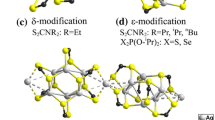Abstract
The synthesis, thermal and spectral characterization and crystal structure of silver(I) complex with picolinamide, [Ag(C6H6N2O)2](NO3)·H2O, are reported. The silver(I) atom is chelated by two picolinamide (pia) ligands in approximately square planar geometry. The distortion within the coordination environment is mainly imposed by formation of the chelate rings, but it is also observed in two longer (Ag–O) and two shorter (Ag–N) bond lengths. The compound crystallizes in the triclinic space group \(P\bar{1}\) with a = 7.1265(2) Å, b = 8.9157(4) Å, c = 12.9527(4) Å, α = 83.934(3)°, β = 86.094(2)°, γ = 67.023(3)° and Z = 2. Cationic complexes are linked through amide–amide hydrogen bonds of ‘head-to-head’ R 22 (8) motif leading to infinite chains, while nitrate anions and H2O molecules act only as a cross-link between such four symmetry related cationic chains via hydrogen bonds forming 2D supramolecular double sheets. Therefore, the ‘head-to-head’ amide interactions in [Ag(C6H6N2O)2](NO3)·H2O are robust enough to accommodate the usually disruptive NO3 − anion and H2O molecule and could be regarded as a tool for controlling the assembly of this silver complex.
Index Abstract
Square planar silver(I) complex with picolinamide, [Ag(pia)2]+, propagates through self-complementary amide hydrogen bonds, forming a supramolecular chain structure. The amide–amide interactions are robust enough to accommodate the usually disruptive NO −3 anion and H2O molecule.





Similar content being viewed by others
References
Brammer L, Burgard MD, Eddleston MD, Rodger CS, Rath NP, Adams H (2002) CrystEngComm 4:239
Brammer L (2004) Chem Soc Rev 33:476
Young G, Hanton LR (2008) Coord Chem Rev 252:1346
Đaković M, Popović Z (2007) Acta Crystallogr C63:m507
Đaković M, Popović Z (2008) Acta Crystallogr E64:m311
Đaković M, Popović Z, Giester G, Rajić-Linarić M (2008) Polyhedron 27:210
Đaković M, Jagličić Z, Kozlevčar B, Popović Z (2010) Polyhedron 29:1910
Oxford Diffraction, 2004. Oxford Diffraction Ltd., Xcalibur CCD System, CrysAlis Software System, Version 171.31
Sheldrick GM (2008) Acta Crystallogr A64:112
Farrugia LJ, ORTEP-3 (1997) J Appl Crystallogr 30:565
Bruno IJ, Cole JC, Edgington PR, Kessler MK, Macrae CF, McCabe P, Pearson J, Taylor R (2002) Acta Crystallogr B58:389
Bakiler M, Bolukbasi O, Yilmaz A (2007) J Mol Struct 826:6
Akalin E, Akyuz S (2006) Vib Spectrosc 42:333
Nakamoto K (1997) Infrared and Raman Spectra of Inorganic and Coordination Compounds. Wiley, New York
Constable EC, Housecroft CE, Kariuki BM, Kelly N, Smith CB (2002) Inorg Chem Commun 5:199
Muthu S, Yip JHK, Vittal JJ (2001) J Chem Soc Dalton Trans 3577
Chen XD, Mak TCW (2005) J Mol Struct 748:183
Deloume JP, Faure R, Loiseleur H (1997) Acta Crystallogr B33:2709
Drew MGB, Naskar JP, Choedhury S, Datta D (2005) Eur J Inorg Chem 23:4834
Bowmaker GA, Effendy, Nitiatmodjo M, Skelton BW, White AH (2005) Inorg Chim Acta 358:4327
Allen HF, Motherwell WDS (2002) Acta Crystallogr B58:380
Beatty AM (2003) Coord Chem Rev 246:131
Aakeröy CB, Beatty AM, Desper J, O’Shea M, Valdés-Martínez J (2003) J Chem Soc Dalton Trans 3956
Aakeröy CB, Beatty AM (1998) Cryst Eng 1:39
Sieron L, Bukowska-Strzyzewska M (1999) Acta Crystallogr C55:491
Mad’arova M, Sivak M, Kuchta L, Marek J, Benko J (2004) J Chem Soc Dalton Trans 20:3313
Đaković M, Popović Z (2007) Acta Crystallogr C63:m557
Acknowledgments
The research was supported by Ministry of Science, Education and Sport of the Republic of Croatia, Zagreb (Grant no. 119-1193079-1332).
Author information
Authors and Affiliations
Corresponding authors
Rights and permissions
About this article
Cite this article
Đaković, M., Benko, M. & Popović, Z. Supramolecular Architecture via Self-Complementary Amide Hydrogen Bonding in [Ag(pia)2](NO3)·H2O: Synthesis, Thermal and Structural Studies. J Chem Crystallogr 41, 343–348 (2011). https://doi.org/10.1007/s10870-010-9885-5
Received:
Accepted:
Published:
Issue Date:
DOI: https://doi.org/10.1007/s10870-010-9885-5



